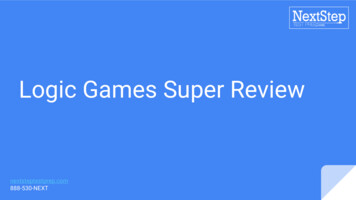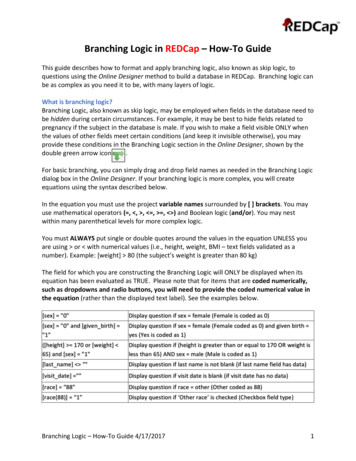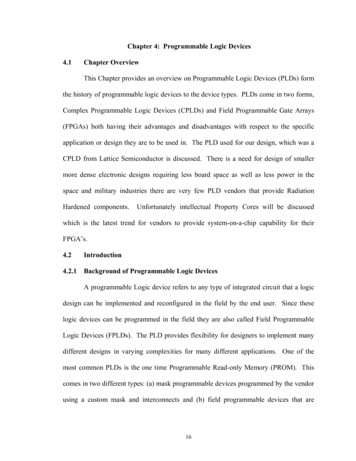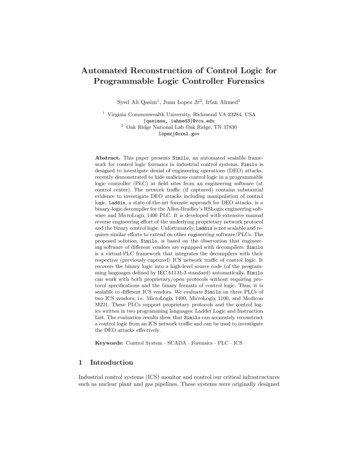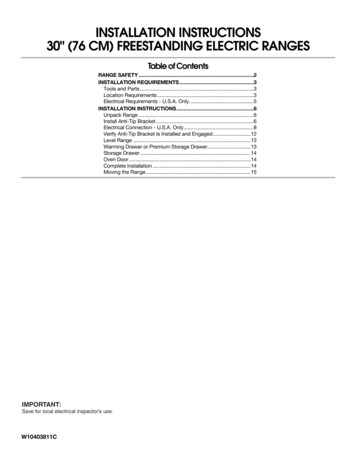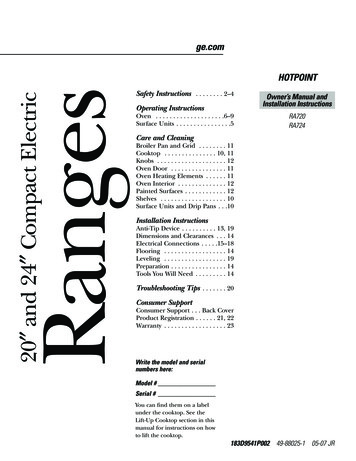
Transcription
Personal ResponsibilityEducation ProgramUsing Logic Models to Guide Program Implementationand Ongoing Program ImprovementsSeptember 2020OVERVIEWLogic models are usually created during program planning andare often forgotten once the program is funded orimplementation begins. This tip sheet offers severalconsiderations for how PREP programs can use logic models asa living document to support communications, planning andimplementation, evaluation, and continuous improvementthroughout the life of a program.Revisiting Your Logic ModelYour logic model is your roadmap to success! Have you everlooked back at your logic model to review, update, or adjust itso that it reflects the changes or adaptations that you havemade along the way? Ask yourself: Does my current logic model accurately reflect my programtoday?There are many benefits to using and reflecting on your logicmodel throughout the life of your program. Logic models can beused through all phases of program implementation andevaluation. Your logic model can be used as a tool to: Communicate important points about your program andengage and train others.Plan efficiently and prioritize resources for implementation.Design and implement your evaluation.Guide changes as you monitor progress and fidelity.1What Is a Logic Model?A logic model is a graphic illustration of therelationship between a program’s resources orinputs required to implement a program, theactivities and outputs of a program, and thedesired outcomes (short term, long term) of aprogram. Logic models clearly and concisely showhow interventions affect behavior and achieve agoal. Logic models are effective tools to assist inprogram planning, implementation, management,evaluation, and reporting. There is a strongconnection between program success and using alogic model (WK Kellogg Foundation, 2006).Typically, logic models include four corecomponents. Logic models can vary in level ofdetail and complexity considering who will use thelogic model and how they will use it (CDC LogicModel Components).For adolescent and teen pregnancy preventionprograms, think of a visual roadmap that showsthe planned links between the work programs do(e.g., communications campaign, school-basedprograms) and the outcomes programs want toachieve (e.g., increased awareness of STIs).
Plan to revisit your logic model at regular intervals with key stakeholders.Using Logic Models as a Communication, Training, and Engagement ToolAs a communication tool, your logic model provides a commonYour logic model can answer:understanding to stakeholders, community partners and sub How does a parent night supportawardees, your staff, and your local evaluator. The logic modelproject retention and parent-childprovides a common framework and language for all stakeholderscommunication about informationfrom which to work (McLaughlin & Jordan, 2010). It is often easieryouth receive as part of theto communicate clearly and quickly using the logic model thancurriculum?describing the entire project verbally or sharing the entire written How do activities outside of theimplementation plan. You might consider differing levels of detailcurricula (such as Adultin the version of the logic model you present to variousPreparation Subjects) fit into thestakeholders (e.g., community, staff, evaluator, educator). Thisproject?allows each group to focus on the elements of the logic model thatare most important to their individual mission or stake in theproject, while not losing sight of the big picture. This can beUse your logic model to train newparticularly important when training new staff members or newstaff or sub-awardees to help orientcommunity partners. Your logic model is an important tool to helpthem more quickly by learningprogram delivery staff understand how your program elements areabout the components of theexpected to lead to desired outcomes. This increases their abilityproject and how they work togetherto work flexibly with different youth, while maintaining adherenceto produce outcomes.to the underlying program theory.Use your logic model to engage your stakeholders, staff, andcommunity partners to communicate inputs, activities, outputs, and outcomes.InputsActivitiesOutputsOutcomesUsing Logic Models for Program Planning and ImplementationYour logic model provides a visual presentation that concisely describes not only the community resources,inputs, activities, outputs, and outcomes of the project, but how each piece will work together and influencethe others. It can show how the curriculum or program you have selected, and other project activities, fittogether and complement each other to produce desired outcomes. A good logic model clearly definesimplementation activities and objectives. It should clearly lay out what the project is expected to accomplish—both in how the project is implemented and what impact it is expected to have on participants and thecommunity. Planning is more efficient when stakeholders know the specifics about the project (e.g., Howmany sessions? Who are the participants?) The logic model shows what should happen during projectimplementation. You might want to start by translating the inputs and activities into a workplan specifyingtimelines and responsible parties. Sometimes, you may need to answer additional questions, such as thoselisted in the graphic below:2
If you expand your program to new settings, serve new populations, or engage new sub-awardees, youshould revisit and update your logic model to make sure it stays current, relevant, and reflective of yourcurrent program.Using Logic Models for EvaluationA clear and comprehensive logic model can (and should) provide the roadmap for your evaluation andfacilitate communication between project staff and your evaluator. Your logic model helps to define what isgoing to be evaluated, including the important elements of your program to measure as part of your processevaluation and the critical outcomes to measure as part of your outcome evaluation. Your logic model helps tofocus your evaluation and must be updated as changes occur.You and your stakeholders will want information about whether and how your program worked. Use yourlogic model to inform evaluation questions based on linkages between activities, outputs, and outcomes. Yourlogic model helps to interpret evaluation results and may assist in answering the following questions: Why did we observe the outcomes that we did? What specific resources were associated with successful program activities?3
How did program activities achieve outputs and outcomes?Were the outcomes uniform across all participants, or did some show better outcomes than others?Are all of the project inputs and community resources necessary to support project activities and achieveobserved outcomes?Using Logic Models for Continuous Quality Improvement (CQI)Logic models are great blueprints for guiding Continuous Quality Improvement (CQI). CQI is a systematicapproach that uses information obtained through program monitoring and evaluation to make improvementsthroughout the lifecycle of a project. You can use CQI processes to reflect on what you did, whether it worked,and how you can improve it. These processes can happen as soon as problems are identified during projectimplementation (mid-course CQI) or as part of a systematic assessment of project functioning (strategic CQI).Regardless of the type of CQI you use, when the need for quality improvements is identified, it is critical toconsult your logic model and review each of the components and linkages between components to ensure youare progressing as intended or to identify whether your logic model needs to be revised if you are not.SUMMARYYour logic model is your roadmap to success! You should: Revisit the logic model throughout project implementation and evaluation. Explain the benefits of doing this to your team. Use your logic model in project planning, implementation start-up, and mid-course corrections. Refer to the logic model to communicate with your local evaluator and to inform evaluation planning. Seek technical assistance through your Project Officer, if needed, about your project’s logic model,implementation, or evaluation.4
Use this Logic Model Reflection Worksheet to review, update or adjust to ensure that your logic model accurately reflects your currentprogram.InputsDid we get the inputswe expected?ActivitiesWere the activitiesimplemented asintended?OutputsDid we get all ouroutputs?Were outputs theexpected quality?Short TermMed TermLong TermWhich outcomes were obtained and to what extent?Did we have enoughresources?Was the selectedsetting feasible forimplementation?Are we reaching ourintended population?Is the project capturing our critical elements?Are we fully staffed?Do we need to makeadaptations to ouractivities?Are we servingparents and otheradults?Does our data suggest benefits from our project so far?Are we missing criticalpartners?Does our curricula fitour population?Is the dosage of ourintervention enough?Are sub-awardeessupporting ourprevention activities?CQI Considerations:Do we havedocumentation ofplanned/unplannedadaptations?How has the programbeen adapted forcultural/communityfit?How has the programbeen adapted inresponse to externalfactors (e.g., virtualimplementation)?5
REFERENCES AND RESOURCESMcLaughlin, J. A. & Jordan, G. B. (2010). Using logic models. In J. S. Wholey, H. P. Hatry, K. E. Newcomer (Eds.),Handbook of practical program evaluation. New York: John Wiley & Sons, pp. 55–80.W. K. Kellog Foundation. (2004). Logic model development guide. Retrieved August 28, 2020, ces/2004/01/logic-model-development-guideLogic Model ResourcesFamily & Youth Services Bureau. Implementation and Evaluation: Using Your Logic Model to Guide YourProjectCenter for Community Health and Development at the University of Kansas. Community Toolbox: Section 1.Developing a Logic Model or Theory of ChangeInnovation Network. (2010). Logic model workbook. Retrieved August 28, 2020, fromhttp://www.innonet.org/client docs/File/logic model workbook.pdfUniversity of Wisconsin-Madison Extension. Program Development and Evaluation: Logic ModelsLogic Model Online Course: https://lmcourse.ces.uwex.edu/PDF: files/2016/03/lmcourseall.pdfLogic Model Training pment/files/2016/03/lmguidecomplete.pdfLogic Model Resources: logicmodels/bibliography/Additional ResourcesAshley, O. S., Stahl, M. H., Banks, D., Vance, M. M., & Palen, L. (2013). Implementation and evaluation: Usingyour logic model to guide your project. Webinar presented to Family and Youth Services BureauCompetitive Personal Responsibility Education Program grantees and Competitive Abstinence Educationgrantees.Ashley, O. S., Herman-Stahl, M. A., Banks, D., Vance, M. M., Kan, M. L., Gremminger, M. M. & Palen, L. (2013,March). Using your logic model to guide your project. Washington, DC: Administration on Children, Youthand Families and Youth Services Bureau.Drake, P. & Laris, B. A. (2011) Logic model training webinar. Presented to Family and Youth Services BureauState Personal Responsibility Education Program grantees.This tip sheet was developed by ETR Associates, a subcontractor to RTI International under contract#HHSP233201500039I/HHSP23337003T Task 4 with the U.S. Department of Health and Human Services, Administrationon Children, Youth and Families, Family and Youth Services Bureau.Suggested Citation: Drake, P., Laris, B. A., Unti, L. (2020). Using Logic Models to Guide Program Implementation andOngoing Program Improvements. Washington, DC: Administration on Children, Youth and Families, Family and YouthServices Bureau.6
Logic models are great blueprints for guiding Continuous Quality Improvement (CQI). CQI is a systematic approach that uses information obtained through program monitoring and evaluation to make improvements throughout the lifecycle of a project. You can use CQI processes to reflect on what you did, whether it worked,


